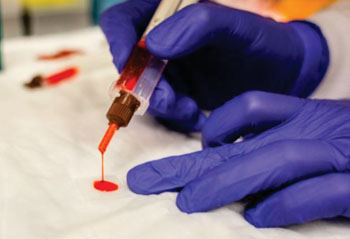Tailored Tissue Adhesives Reduce Postsurgical Leakage
By HospiMedica International staff writers
Posted on 09 Feb 2015
New tissue sealants must take into account the environment in which the material will be used, instead of using a “one-size fits all” approach, claims a new study.Posted on 09 Feb 2015
Researchers at the Massachusetts Institute of Technology (MIT; Cambridge, MA, USA) developed a novel tissue adhesive by combining two polymers: the polysaccharide dextran and a highly branched polymer chain dendrimer. They then explored what happens when the adhesive is used in the same organ, but under different pathological conditions. They found that the adhesive performed better in cancerous colon tissue than in healthy tissue, but that it performed worse in tissue inflamed with colitis, again compared to healthy tissue.

Image: A new tissue adhesive helps repair surgical incisions following colon surgery (Photo courtesy of Jose-Luis Olivares/MIT).
Further studies of the molecular interactions between adhesive and tissue demonstrated that the tissue glue works via amine complexes found in collagen. When enough of these complexes bind to each other, the adhesive forms a tight seal. The binding system of the two polymers is disrupted, however, in colitic tissue, because inflammation causes the breakdown of collagen; the more severe the inflammation, the less adhesion occurs. On the other hand, since cancerous tissue tends to have excess collagen, the adhesive ends up working better than in healthy tissue.
The researchers then created a model to help them alter the composition of the material, depending on the necessary circumstances. By changing the materials’ molecular weight, the number of the bonds of each polymer, and the ratio of the dendrimer/dextran formulation, the researchers were able to tune the tissue adhesive to perform optimally in different types and states of tissue. The study describing the development of the glue was published on January 28, 2015, in Science Translational Medicine.
“Detailed study of tissue and biomaterial interactions can open a new chapter in precision medicine, where biomaterials are chosen and rationally designed to match specific tissue types and disease states,” said lead author Natalie Artzi, MD, PhD, of the MIT Institute for Medical Science and Engineering (IMES). “We can take a biopsy from a patient for a quick readout of disease state that would serve as an input for our model, and the output is the precise material composition that should be used to attain adequate adhesion. This exercise can be done in a clinical setting.”
Dendrimers are repetitively branched molecules; the name comes from dendron, the Greek word for tree. A dendrimer is typically symmetric around the core, adopting a spherical three-dimensional (3D) morphology that is characterized by structural perfection. The properties of dendrimers are dominated by the functional groups on the molecular surface; thus it is possible to make dendrimers water soluble, unlike most polymers, by functionalizing their outer shell with charged species or other hydrophilic groups. Other controllable properties include toxicity, crystallinity, and chirality.
Related Links:
Massachusetts Institute of Technology














